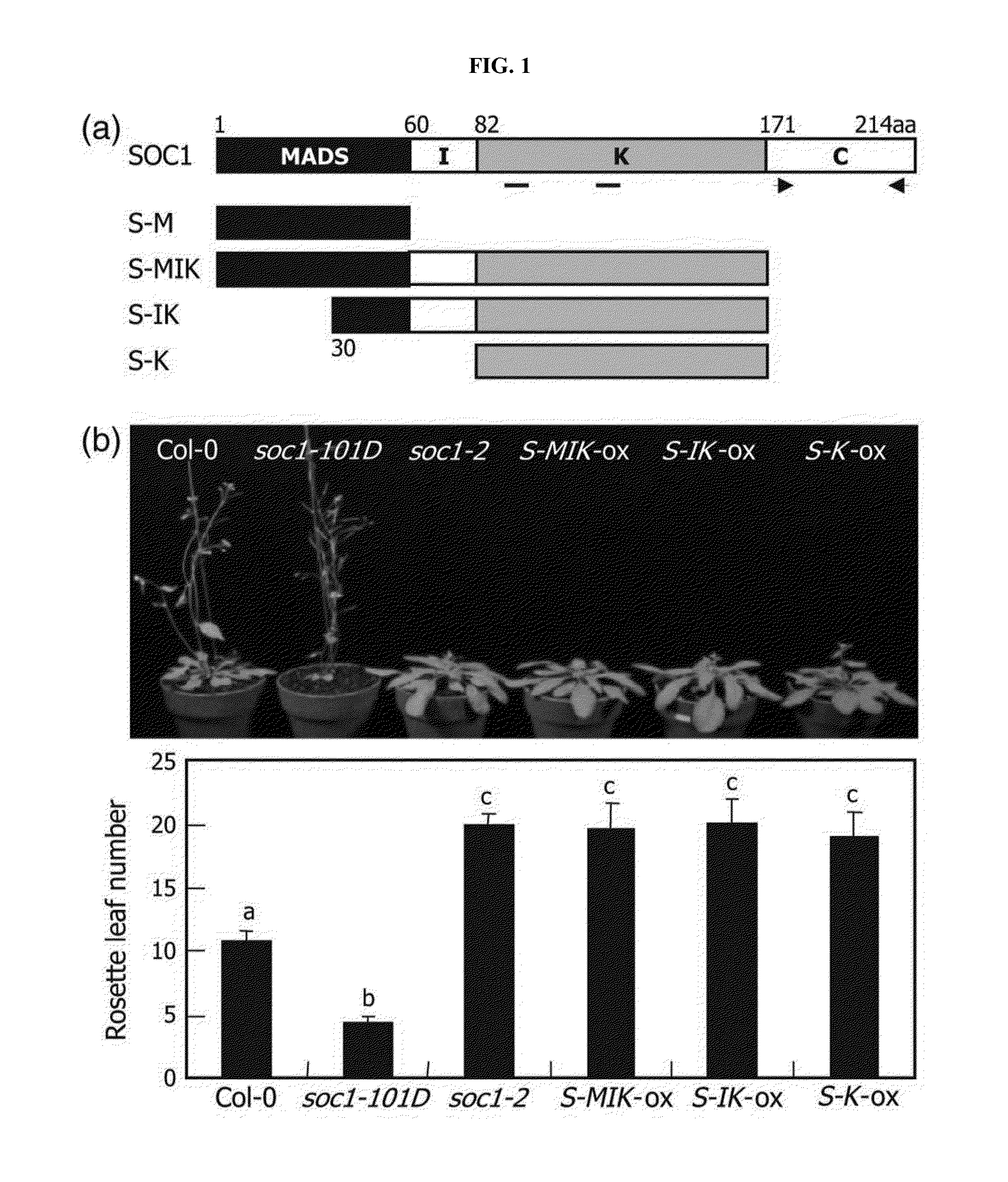Method for inactivating target transcription factor using artificial small interfering peptide and use thereof
a technology of transcription factor and target, which is applied in the direction of peptides, peptide/protein ingredients, peptide sources, etc., can solve the problems of rna interference (rnai), suffer from off-target effects, and still difficult to target gene inactivation, etc., and achieve high precision and efficiency
- Summary
- Abstract
- Description
- Claims
- Application Information
AI Technical Summary
Benefits of technology
Problems solved by technology
Method used
Image
Examples
example 1
a-siPEP Overproduction Leads to SOC1-Deficient Phenotypes in Arabidopsis
[0079]It has been estimated that at least 80 potential siPEPs are encoded by the Arabidopsis genome (Seo et al., Trends Plant Sci. 16, 541-549, 2011). Structural analysis of the genomic siPEPs identified so far depicts that they generally possess dimerization domains but lack other protein domains that are required for DNA binding and transcriptional regulation.
[0080]The Arabidopsis SOC1 transcription factor has four distinct domains. The MADS domain is responsible for DNA binding, and the K (keratin-like) domain mediates protein-protein interactions (FIG. 1a). The I (intervening) domain also contributes to SOC1-SOC1 homodimer formation. The C-terminal region performs diverse functions in transcriptional regulation (Kaufmann et al., Gene, 347, 183-198, 2005). Based on the structural criteria defined by the known siPEPs, inventors of the present invention designed a series of potential a-siPEPs of the SOC1 trans...
example 2
SOC1 a-siPEPs Inhibit Nuclear Import and DNA Binding of SOC1
[0083]It has been known that homo- and heterodimer formations of MADS transcription factors are critical for their binding to target gene promoters (Kaufmann et al., Gene, 347, 183-198, 2005). Inventors of the present invention therefore hypothesized that the truncated SOC1 forms interfere with the SOC1 activity by forming nonfunctional dimers. Yeast-two-hybrid assays revealed that SOC1 forms homodimers (FIG. 3a). It also interacted with the truncated SOC1 forms, such as S-MIK, S-IK, and S-K. in vitro pull-down assays using a recombinant maltose-binding protein-SOC1 (MBP-SOC1) fusion prepared in E. coli cells and truncated SOC1 polypeptides, which were produced by in vitro translation, confirmed the formation of SOC1-SOC1 homodimers and heterodimers with the truncated SOC1 forms (FIG. 3b).
[0084]Inventors of the present invention next investigated whether the truncated SOC1 forms attenuate the formation of SOC1-SOC1 homodime...
example 3
a-siPEP-Mediated Inactivation is Also Applicable to AG in Arabidopsis
[0086]A question was whether the a-siPEP-mediated inactivation is also applicable to other transcription factors. To examine this, inventors of the present invention produced a series of truncated forms of AG transcription factor (FIG. 4a), which plays a role in floral architecture, and they were overproduced in Col-0 plants. Overall phenotypes of the Arabidopsis plants overproducing the truncated AG forms were indistinguishable from those of Col-0 plants. Interestingly, the transgenic plants overproducing the truncated AG forms containing K domain displayed disrupted floral structure, as observed in ag-3 knockout mutant (FIG. 4b). In addition, whereas overproduction of AG-K caused abnormal floral structure, that of AG-mK having a point mutation in the K domain and thus being unable to interact with AG had no discernible effects on flower development. These observations support that the negative effects of AG-K on...
PUM
| Property | Measurement | Unit |
|---|---|---|
| time | aaaaa | aaaaa |
| temperatures | aaaaa | aaaaa |
| temperatures | aaaaa | aaaaa |
Abstract
Description
Claims
Application Information
 Login to View More
Login to View More - R&D
- Intellectual Property
- Life Sciences
- Materials
- Tech Scout
- Unparalleled Data Quality
- Higher Quality Content
- 60% Fewer Hallucinations
Browse by: Latest US Patents, China's latest patents, Technical Efficacy Thesaurus, Application Domain, Technology Topic, Popular Technical Reports.
© 2025 PatSnap. All rights reserved.Legal|Privacy policy|Modern Slavery Act Transparency Statement|Sitemap|About US| Contact US: help@patsnap.com



